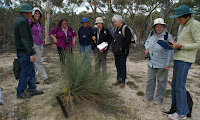Over the last year or so Wheatbelt
NRM has been mapping and eradicating Bridal Creeper and Small Flower
Tamarisk infestations along the Avon River - and we are now looking to
share our new knowledge and useful experiences from these activities
with the wider community.
How do you get a handle on invasive weeds growing along a major watercourse?
What do you do when you find a nasty infestation of Bridal Creeper (Asparagus asparagoides) climbing over your back fence?
 |
| Treated Small Flower Tamarisk |
Does the Avon community need to tackle Weeds of National Significance like Bridal Creeper and Small Flower Tamarisk (Tamarisk parviflora) growing along the Avon River?
How do you eradicate a Small Flower Tamarisk plant over 5m high and 7m across??
These are just some of the questions that will be answered at the Weed Wars & The Great Escape workshop in York on Saturday 27th April 2013.
This exciting weekend workshop will provide participants with an opportunity to:
- learn up-to-date- techniques for managing Weeds of National Significance (WONS) in the Avon region
- identify Bridal Creper and Small Flower Tamarisk,
- hear from experienced weed controllers about control efforts undertaken so far along the Avon!
NEWS FLASH!
Josh Byrne (from ABC TV) will be presenting at this workshop!!
So come along and hear about how your efforts in your rural town garden can make a difference to the Weed War being waged Along the Avon River!
To find out more please visit the Weed Wars and The Great Escape website and register for the workshop.















